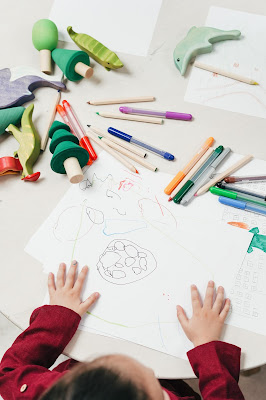Infants displays palmar grasp which is when an object is placed in an Infant’s hand and the palm
of the child is stroked, the fingers will close reflexively, as the object is grasped via palmar grasp.
of the child is stroked, the fingers will close reflexively, as the object is grasped via palmar grasp.
The next developmental milestone is between seven and twelve months, when a series of fine motor skills begins to develop. These include, but are not limited to, increase in grip, enhancement of vision, pointing with the index finger, smoothly transferring objects from one hand to the other, as well as using the pincer grip (with the thumb and
index fingers) to pick up tiny objects with precision.
index fingers) to pick up tiny objects with precision.
A lot of factors change in grasping when the infant becomes seven months. The infant will have better chance of grasping due to the fact that the infant can sit up on their own. Therefore, the infant will not fall over. The infant grasping also changes. The infant starts to hold objects more properly when age increases.
Fine motor skills
Fine motor skill (or dexterity) is the coordination of small muscles, in movements, usually involving the synchronization of hands and fingers with the eyes.
Writing is without a doubt is a fine motor skill as it requires subtle motions of hands and fingers.
Fine motor skills aid in the growth of intelligence and develop continuously throughout the stages of human development.
Static tripod grasp technique
The proper way to hold a pencil is called the “tripod grip”.
It can be challenging to teach kids to use the tripod grip, once they have learned an improper grip.
Children typically attend preschool between the ages of 2 and 5. At this time, the child is capable of grasping
objects using the static tripod grasp, which is the combined use of the index, thumb, and middle finger. A preschooler’s motor skills are moderate, allowing the child to cut shapes out of paper, draw or trace over vertical
lines with crayons, button their clothes, and pick up objects.
A preferred hand dominates the majority of their activities. They also develop sensory awareness
and interpret their environment by using their senses and coordinate movements based on that.
objects using the static tripod grasp, which is the combined use of the index, thumb, and middle finger. A preschooler’s motor skills are moderate, allowing the child to cut shapes out of paper, draw or trace over vertical
lines with crayons, button their clothes, and pick up objects.
A preferred hand dominates the majority of their activities. They also develop sensory awareness
and interpret their environment by using their senses and coordinate movements based on that.
Improving the static tripod grasp technique will ultimately lead the child towards dynamic tripod griping despite the Montessori
material there are a whole bunch of things and activities you can do to improve
it.
material there are a whole bunch of things and activities you can do to improve
it.
Hands on Activity
Appreciating the Montessori approach of reading and
writing sharing a quote of Maria Montessori:
writing sharing a quote of Maria Montessori:
“Never give to the mind more than you give to the hand”
1. Sand Paper Letters:
The
sandpaper letter provides a rough tactile experience for the child as they
trace it with their two fingers. This creates a strong mental image in the
brain as they learn that these symbols are connected to a sound.
sandpaper letter provides a rough tactile experience for the child as they
trace it with their two fingers. This creates a strong mental image in the
brain as they learn that these symbols are connected to a sound.
2. Rice tracing
The
most classical one is the Rice tracing game same as Sand tracing. The child can
trace objects or alphabets using the index finger on the rice.
most classical one is the Rice tracing game same as Sand tracing. The child can
trace objects or alphabets using the index finger on the rice.
3. Sorting Toy
I
personally love this Alphabet sorting game I would recommend this for
vocabulary development too.
personally love this Alphabet sorting game I would recommend this for
vocabulary development too.
4. Building Blocks
Building
blocks is also a fun learn activity indulges the child in great hand and eyes
coordination.
blocks is also a fun learn activity indulges the child in great hand and eyes
coordination.
5. Activity with tongs
Any
activity that involves child friendly tongs develops pincer grip. following is my recommendation.
activity that involves child friendly tongs develops pincer grip. following is my recommendation.
6. Pegging
Any sorting game that involves pegging it could be color sorting or anything your child would love to do.
7. Sand Tray
The sand tray is a fun
sensorial experience for the child to practice forming shapes and lines with
their fingers. Eventually, letters can be formed in the sand.
sensorial experience for the child to practice forming shapes and lines with
their fingers. Eventually, letters can be formed in the sand.
8. Play dough or Kinetic Sand
Activities that may involve rolling with hands or a rolling pin, hiding objects such as coins in the play dough or just creative construction.
Activities that may involve rolling with hands or a rolling pin, hiding objects such as coins in the play dough or just creative construction.
9. Free Play
dough Mats (Activity)
Once laminated the mats are used
with play dough or dry erase markers to practice letter formations of both
uppercase and lowercase letters.
with play dough or dry erase markers to practice letter formations of both
uppercase and lowercase letters.
In order to improve child’s
awareness regarding the shape and position of the alphabets on the line, the
child is introduced to sorting exercises. The exercise which gives the child
the concept of grass letters, root letters and sky letters actually prepares
the child indirectly for writing on paper since the child gets a clear concept
of the place and position of each alphabet on the line.
awareness regarding the shape and position of the alphabets on the line, the
child is introduced to sorting exercises. The exercise which gives the child
the concept of grass letters, root letters and sky letters actually prepares
the child indirectly for writing on paper since the child gets a clear concept
of the place and position of each alphabet on the line.
You
can always get free items from @thelovingmontessoridirectress. Grab your Free
mats
now by clicking (here).
can always get free items from @thelovingmontessoridirectress. Grab your Free
mats
now by clicking (here).
Prewriting Skills:
Once the child has developed static tripod grip or
pincer grip it is vital for you to bring the child towards the development
of pre-writing skills.
pincer grip it is vital for you to bring the child towards the development
of pre-writing skills.
A major component
of pre-writing skills are the pre-writing shapes. These are the pencil
strokes that most letters, numbers and early drawings are comprised of.
They are typically mastered in sequential order, and to an age specific
level. These strokes include the following strokes: |, —, O, +, /, square,
, X, and Δ.
of pre-writing skills are the pre-writing shapes. These are the pencil
strokes that most letters, numbers and early drawings are comprised of.
They are typically mastered in sequential order, and to an age specific
level. These strokes include the following strokes: |, —, O, +, /, square,
, X, and Δ.
If an aspect of a project is frustrating to the
child, provide assistance – try to keep things fun, introduce coloring
sheets. Sing songs, read stories or watch shows with a similar theme as
the worksheet you choose to supplement the project – again focusing on
extra activities that the child enjoys to help keep them motivated.
child, provide assistance – try to keep things fun, introduce coloring
sheets. Sing songs, read stories or watch shows with a similar theme as
the worksheet you choose to supplement the project – again focusing on
extra activities that the child enjoys to help keep them motivated.
Free Stroking and Coloring Worksheets:
You can always get free items from
@thelovingmontessoridirectress . Grab your Free
Worksheets now by clicking (here)
@thelovingmontessoridirectress . Grab your Free
Worksheets now by clicking (here)





